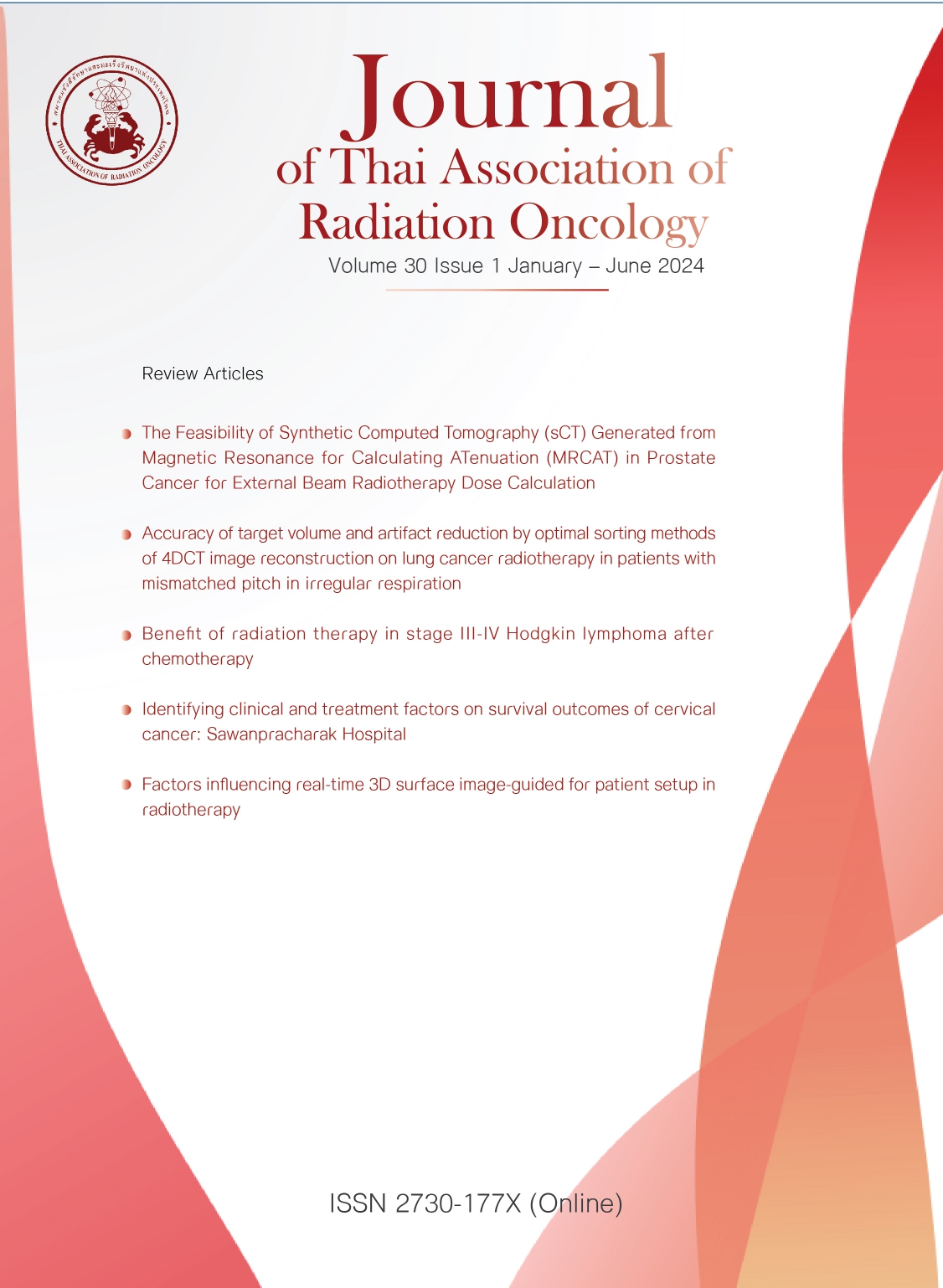Identifying clinical and treatment factors on survival outcomes of cervical cancer: Sawanpracharak Hospital
Keywords:
Cervical cancer, overall survival rate, progression-free survival, prognostic factorsAbstract
Backgrounds Cervical cancer is the fourth most common cancer in women globally, including Thailand. The main treatments for locally advanced cervical cancer are concurrent chemoradiation and brachytherapy. Several risk factors are associated with survival outcomes.
Objectives To identify clinical, pathology, and treatment factors that impact on overall survival (OS) and progression-free survival (PFS) in locally advanced cervical cancer.
Materials and Methods A retrospective study of an explorative prognostic factor research was conducted in locally advanced cervical cancer patients treated in Sawanpracharak Hospital from 2017 to 2019. Kaplan-Meier and Log-rank test were used for survival analysis. Cox regression was used for univariate and multivariate analysis to identify the prognostic factors. P-value <0.05 was considered statistically significant.
Result There were 179 patients. The mean age was 53 years old. The 3-year overall survival (OS) was 75%, 72.2%, 44.4-66.7% and 46.2% and the 3-year progression-free survival (PFS) was 93%, 74%, 33.3-80% and 38.5% for stage I, II, III and IVA respectively. Multivariable analysis identified risk factors for poor OS included initial hemoglobin level < 10 g/dl (HR 2.63; 95% CI, 1.41-4.89, p=0.002) non-squamous cell histology (HR 2.07; 95% CI, 1.09-3.93, p=0.026) and tumor size ≥4 cm (HR 2.4; 95% CI, 1.05-5.58, p=0.038). Factors associated with worse PFS included non-squamous cell histology (HR 2.40; 95% CI, 1.31-4.39, p=0.004) and tumor size ≥4 cm (HR 3.59; 95% CI, 1.34-9.63, p=0.011). There was no statistically significant difference in the PFS or OS between those who received 5 cycles or less chemotherapy and total treatment time 56 or more days.
Conclusion Initial hemoglobin level < 10 g/dl was a factor associated with worse overall survival, whereas histological cell type and tumor size were prognostic factors associated with overall survival and progression-free survival outcomes in cervical cancer.
References
Rojanamatin J, Ukranun W, Supaattagorn P, Chaiwiriyabunya I, Wongsena M, Chaiwerawattana A, et al. Cancer in Thailand Volume X, 2016-2018. Bangkok; 2021.
WHO guideline for screening and treatment of cervical pre-cancer lesions for cervical cancer prevention [Internet]. 2nd edition. Geneva: World Health Organization; 2021. Available from: https://www.ncbi.nlm.nih.gov/books/NBK572317/
Bangsomboon P, Kittisiam T, Chaowawanit W. Survival Rate of Cervical Cancer Patients According to the 2018 FIGO Staging System: A Tertiary Hospital Based Study, Vajira Hospital, Bangkok. Thai J Obstet Gynaecol. 2022;30:60-67.
Morris M, Eifel PJ, Lu J, Grigsby PW, Levenback C, Stevens RE, et al. Pelvic radiation with concurrent chemotherapy compared with pelvic and para-aortic radiation for high-risk cervical cancer. N Engl J Med. 1999;340:1137-43.
Rose PG, Bundy BN, Watkins EB, Thigpen JT, Deppe G, Maiman MA, et al. Concurrent cisplatin-based radiotherapy and chemotherapy for locally advanced cervical cancer. N Engl J Med. 1999;340:1144-53.
Pötter R, Tanderup K, Kirisits C, de Leeuw A, Kirchheiner K, Nout R, et al. The EMBRACE II study: The outcome and prospect of two decades of evolution within the GEC-ESTRO GYN working group and the EMBRACE studies. Clin Transl Radiat Oncol. 2018;9:48-60.
Perez CA, Grigsby PW, Castro-Vita H, Lockett MA. Carcinoma of the uterine cervix. I. Impact of prolongation of overall treatment time and timing of brachytherapy on outcome of radiation therapy. Int J Radiat Oncol Biol Phys. 1995;32:1275-88.
ภาณุภัทร รักพงษ์, นิสา ชวพันธุ์, เอกสิทธิ ธราวิจิตรกุล. The Impact of overall treatment time on treatment outcome of radiotherapy in cervical cancer. J Thai Assoc of Radiat Oncol. 2016 ;22:20-9.
Serkies K, Jassem J. Concurrent weekly cisplatin and radiotherapy in routine management of cervical cancer: a report on patient compliance and acute toxicity. Int J Radiat Oncol Biol Phys. 2004;60:814-21.
Monk BJ, Tewari KS, Koh WJ. Multimodality therapy for locally advanced cervical carcinoma: state of the art and future directions. J Clin Oncol. 2007;25:2952-65.
Sturdza A, Pötter R, Fokdal LU, Haie-Meder C, Tan LT, Mazeron R, et al. Image guided brachytherapy in locally advanced cervical cancer: Improved pelvic control and survival in RetroEMBRACE, a multicenter cohort study. Radiother Oncol. 2016;120:428-433.
Kunos CA, Fabian D, Fredericks T, Baldwin L, Dietrich C, Miller RW, et al. Hemoglobin level associates with survival in women from Appalachian Kentucky with uterine cervix cancer. Front Oncol. 2023;13:1132135.
Serkies K, Badzio A, Jassem J. Clinical relevance of hemoglobin level in cervical cancer patients administered definitive radiotherapy. Acta Oncol. 2006;45:695-701.
Pötter R, Tanderup K, Schmid MP, Jürgenliemk-Schulz I, Haie-Meder C, Fokdal LU, et al. MRI-guided adaptive brachytherapy in locally advanced cervical cancer [EMBRACE-I]: a multicentre prospective cohort study. Lancet Oncol. 2021;22:538-547.
Rijkmans EC, Nout RA, Rutten IH, Ketelaars M, Neelis KJ, Laman MS, et al. Improved survival of patients with cervical cancer treated with image-guided brachytherapy compared with conventional brachytherapy. Gynecol Oncol. 2014;135:231-238.
Downloads
Published
How to Cite
Issue
Section
License
Copyright (c) 2024 Thai Association of Radiation Oncology

This work is licensed under a Creative Commons Attribution-NonCommercial-NoDerivatives 4.0 International License.
บทความที่ได้รับการตีพิมพ์เป็นลิขสิทธิ์ของวารสารมะเร็งวิวัฒน์ ข้อความที่ปรากฏในบทความแต่ละเรื่องในวารสารวิชาการเล่มนี้เป็นความคิดเห็นส่วนตัวของผู้เขียนแต่ละท่านไม่เกี่ยวข้องกับ และบุคคลากรท่านอื่น ๆ ใน สมาคมฯ แต่อย่างใด ความรับผิดชอบองค์ประกอบทั้งหมดของบทความแต่ละเรื่องเป็นของผู้เขียนแต่ละท่าน หากมีความผิดพลาดใดๆ ผู้เขียนแต่ละท่านจะรับผิดชอบบทความของตนเองแต่ผู้เดียว




